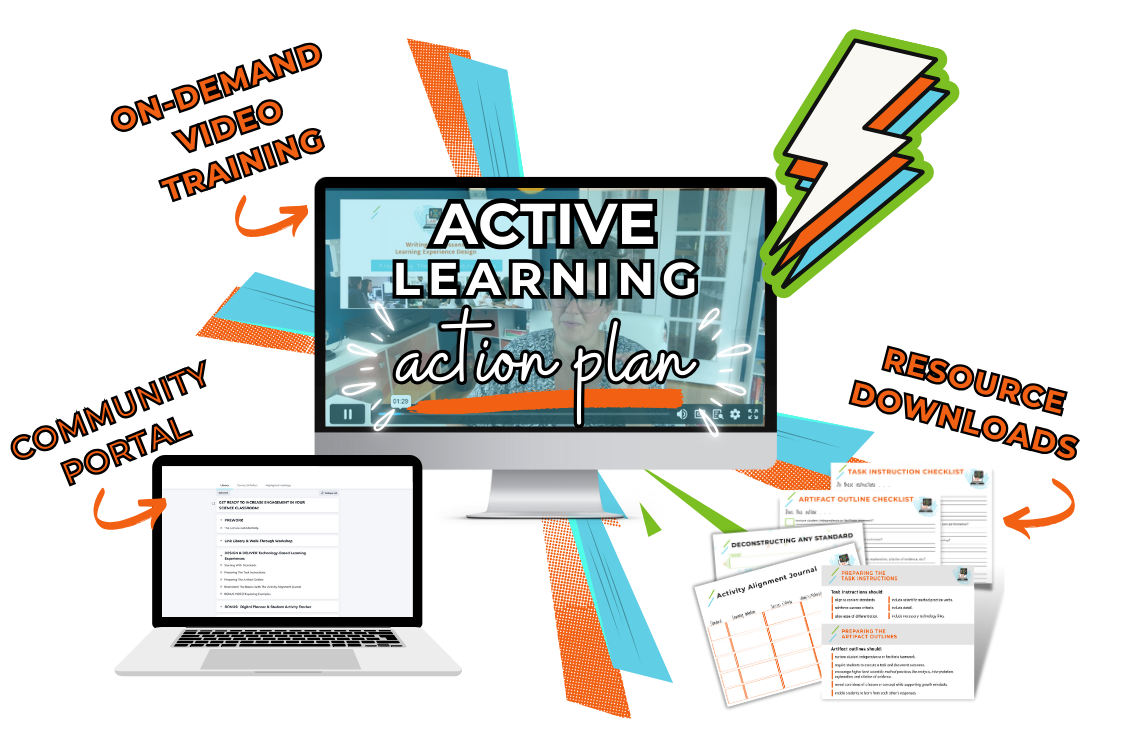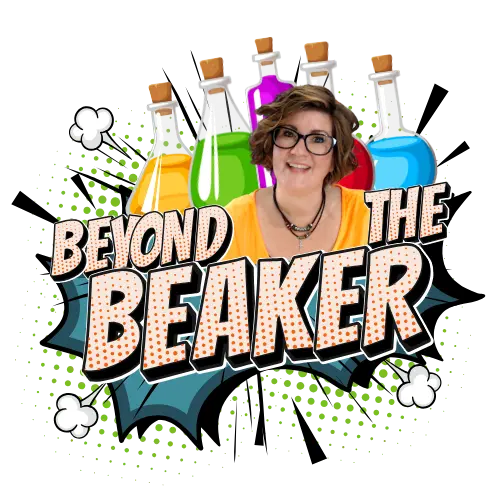We’ve all been there—you spend time preparing an ionization energy worksheet (or searching for a free one online), expecting it to solidify student understanding and provide a source of reference notes for them to study from in the future. And sure, students might complete it without a hitch, but what they won’t tell you is that any traditional worksheet is a total buzzkill! They drain engagement, leaving students bored and disconnected. Plus, when it’s time to explain why ionization energy increases across a period… their confidence evaporates.
Why? Worksheets can’t do the heavy lifting of deep learning. That’s where inquiry-based strategies step in to fill the gap.
If you’re ready to break out of the worksheet rut, let’s explore a more meaningful way to teach secondary science — especially ionization energy!
In this article that describes my high school chemistry ionization energy lesson, you’ll learn how to replace passive recall with student-driven discoveries. The secret is in the inclusion of an inquiry-based science activity that requires the use of science and engineering practices to collect, evaluate, and argue real data to make class time meaningful and memorable for your students.
Rather watch and listen than read? I got you.
TABLE OF CONTENTS
- Your Ionization Energy Worksheet Doesn’t Require This Prior Knowledge (But It Should)
- 5 Science and Engineering Practices That Drive Deep Learning in the Ideal Ionization Energy Worksheet
- 4 Cross-Cutting Concepts Students Will Use when completing the ionization energy worksheet in This Lesson
- 5 Steps to Creating a Student-Centered Lesson Around An Impactful Ionization Energy Worksheet
- A Comprehensive Guide to Teaching Ionization Energy The Lab In Every Lesson Way!
- From Sub Plans to Self-Paced Learning: Digital Tools for Secondary Science Instruction
Your Ionization Energy Worksheet Doesn’t Require This Prior Knowledge (But It Should)
In this lesson on ions and ionization energy, it’s important to highlight that it is not part of a unit all about periodic table trends. Since periodic patterns inform most of atomic structure and electron behavior, it’s introduced near the end of a unit focused on NGSS HS-PS1-1, relating to patterns of electrons in outermost energy levels.

By this point, students should have already explored the Bohr model of the atom, box diagrams that represent Schrodinger’s model, and electron configurations. These models allow students to argue reasoning from evidence about the other periodic trends they would have also already studied, including atomic size, octet rule-based adjustments to valence orbitals, and ion charges.
With regard to the octet rule, students need only recall the need for atoms tend to “do the easiest thing.” Since specific means of bonding aren’t yet introduced at this point, a simplified message will suffice. For example, students need only understand that an atom would rather lose one electron than gain seven because “nature is lazy” – likening to their own laziness when it comes to doing chores or homework. This approach implies an energy component but never actually requires them to call upon energy data to support their predictions about how atoms will satisfy their octets. This ionization energy lesson changes that—it’s the point at which students finally analyze ionization energy data to understand why metals lose electrons while nonmetals don’t.
The only lesson to follow this one in the series focuses on the periodic law. In that lesson, students consolidate everything they’ve learned about the periodic table to identify similarities between elements in a group and recognizing overarching patterns.
In this unit, each lesson creates evidence and reasoning for the next core idea, allowing students to combine what they know with new observations they make to create new knowledge everyday. By carefully designing inquiry-based activities that require the use of science and engineering practices within each lesson, students are guided toward true mastery, building their skills and confidence through direct exploration.
5 Science and Engineering Practices That Drive Deep Learning in the Ideal Ionization Energy Worksheet
This lesson on ionization energy is built around multiple science and engineering practices (SEPs) outlined by NGSS, with a focus on helping students connect quantitative data to the core ideas of atomic structure and periodic trends. Even if you’re not bound to follow NGSS standards, incorporating these practices can breathe new life into your lessons, making them more engaging and meaningful for students.
By integrating science and engineering practices, you can shift from traditional lecture-based teaching to an active, student-centered approach where you become the guide while students take ownership of their learning. Think of this list of practices as your teacher’s playbook for leading students through inquiry-based science activities that replace passive learning with data-oriented discovery.

The following science and engineering practices make this lesson superior to the basic and traditional ionization energy worksheet:
1. Developing and Using Models
In this lesson, students rely on using the periodic table as a model, rather than modeling individual atoms. While previous lessons leading up to this one focus on atomic models and electron configurations, here the periodic table becomes the tool for identifying ionization energy as properties of atoms.
HOW IT’S INTEGRATED INTO THE IONIZATION ENERGY WORKSHEET & WHY IT WORKS:
- Students use the periodic table to argue from evidence, explaining why metals tend to lose electrons while nonmetals don’t.
- This practice helps students connect data to predictions and apply prior knowledge in a new context.
2. Carrying Out Investigations
Although students don’t plan the investigation in this ionization energy lesson themselves, they take an active role in carrying out the investigation by following a structured process to obtain and analyze ionization energy data.
HOW IT’S INTEGRATED INTO THE IONIZATION ENERGY WORKSHEET & WHY IT WORKS:
- Students explore real-world data to uncover patterns and test their predictions.
- This student-controlled approach ensures they engage in authentic scientific practices.
3. (and #4!) Analyzing and Interpreting Data & Obtaining, Evaluating, and Communicating Information
This lesson emphasizes collecting and making inferences from quantitative ionization energy data for multiple atoms. Instead of passively receiving information, students obtain, evaluate, and communicate their findings.
HOW IT’S INTEGRATED INTO THE IONIZATION ENERGY WORKSHEET & WHY IT WORKS:
- Students use an interactive periodic table to collect the values for first ionization energy for select elements across period 2 and down group 1 relative to that of lithium.
- They evaluate and compare the data, connecting it to predictions they made using the octet rule in previous lessons.
- Students use their ionization energy worksheet (which I prefer to call an “artifact outline”) to record and communicate their observations which will support data-based discussion in response to prompts.
- Overall, this practice builds reasoning and argumentation skills in students.
5. Engaging in Argument from Evidence
Arguing from evidence is a core component of this lesson and a feature that we can certainly be intentional about when planning inquiry-based science activities.
HOW IT’S INTEGRATED INTO THE IONIZATION ENERGY WORKSHEET & WHY IT WORKS:
- Students justify their explanations using both ionization energy data and what they have learned about periodic patterns to justify new patterns they identify.
- Collaborative discussions help students refine their arguments and develop stronger reasoning skills.
By integrating these science and engineering practices, this lesson becomes more than a review of periodic trends—it’s an opportunity for students to experience science — to teach it as a verb (a thing we do) rather than as a noun (a collection of facts) — to build critical thinking, reasoning, and communication skills while engaging deeply with real data.
4 Cross-Cutting Concepts Students Will Use when completing the ionization energy worksheet in This Lesson
In addition to integrating the science and engineering practices, this ionization energy lesson calls upon students to use several cross-cutting concepts (CCCs) that help students connect the abstract idea of energy transfer to observable patterns and phenomena. These concepts are not always the primary focus but remain essential for helping students see the bigger picture.

Here’s how these cross-cutting concepts come into play:
1. PATTERNS
Students identify and analyze the pattern of increasing ionization energy across periods and down groups, connecting it to the arrangement of electrons in outermost energy levels.
2. CAUSE & EFFECT
This concept is embedded in the idea that ionization energy represents the amount of energy required for electrons to be removed. The “cause” is the energy input, and the “effect” is electrons escaping their atomic orbitals.
3. SCALE, PROPORTION & QUANTITY
Students explore how ionization energy changes based on the number of electrons, their distance from the nucleus, and the amount of energy applied. This concept helps students understand why some electrons are tightly bound while others require less energy to remove.
4. SYSTEMS AND SYSTEM MODELS
The periodic table serves as a model that helps students explain the relationships between atomic structure and ionization energy. Students refer back to Bohr models and proton-electron interactions to provide evidence and argue reasoning for why some electrons are harder to remove than others.
While it could be argued that the inquiry-based science activity in this lesson touches on the energy and matter theme, it definitely doesn’t emphasize structure and function. At this point in the sequence of lessons, we want to keep the focus on electron behavior rather than bonding. However, if you would teach this ionization energy lesson in the context of or just preceding ionic bonding, you would just adjust the learning objectives to emphasize how electron removal relates to structure and function in forming ionic compounds.
By weaving these cross-cutting concepts into your learning goals, you give students a richer understanding of how ionization energy fits into the broader framework of atomic behavior and chemical reactions. If you’re interested in learning more about how to lead your lesson planning efforts with cross-cutting concepts like these, be sure to read my article, “How To Use Cross-Cutting Concepts For Perfect Lesson Plans”.
5 Steps to Creating a Student-Centered Lesson Around An Impactful Ionization Energy Worksheet
Every lesson I design follows a structured framework to ensure it’s active, student-centered, and inquiry-driven. This framework transforms passive learning into student-driven discovery, helping students take ownership of their learning while building key reasoning skills.

Here’s a quick overview of the five key parts I strive to include each every lesson I design and deliver:
1. Review and Preview for a welcoming Warm-Up
The lesson starts with a “Review and Preview” activity designed to activate prior knowledge and make connections to new content. This isn’t a generic vocabulary check; it’s an opportunity for students to link their former academic or life experiences to the concepts they’ll explore in the lesson. Often, the warm-up sets up the core idea so effectively that students already grasp half of the main concept by the time it’s complete!
In this ionization energy lesson, the activity focuses on student predictions about electron transfer and energy—helping them bridge previous lessons on ion charges to what’s ahead.
2. Learning Intentions and Success Criteria for the what, why, and how
Learning intentions and success criteria help students answer two essential questions: “Why does this matter?” and “What do I need to achieve today?”
- Learning intentions explain the context and purpose of the lesson, showing students how it fits into the broader scope of predicting chemical change.
- Success criteria provide a checklist students can use to monitor their learning and reflect on their progress throughout the lesson and unit.
In this lesson, success criteria focus on analyzing ionization energy data, identifying patterns, and explaining how energy affects electron transfer.
3. Observation-based Learning Activity embedded within an inquiry-based ionization energy worksheet for note-taking
This is the heart of the lesson—the point at which students engage in active discovery rather than passive note-taking. Most of my activities are simulation-based, but when that’s not possible, I use interactive tutorials, videos, or text-based investigations.
In this lesson, students analyze ionization energy data using an interactive periodic table, connecting it to prior concepts like electron configurations and periodic trends. The activity guides students through discovery, with no lecture required.
4. Data-Dependent Analysis keeps science and engineering practices a primary focus
Once they have finished observing and recording their observations, students dive deep into the data. They analyze either quantitative data or qualitative observations to find patterns, apply math concepts, and engage in various science and engineering practices like constructing explanations and asking further questions.
For this lesson, students work with quantitative ionization energy data to uncover relationships between atomic structure and energy requirements. This analysis strengthens their reasoning skills and prepares them for evidence-based discussions.
5. Skill Practice and formative Assessment to wrap up and reinforce
Every lesson ends with skill practice that reinforces the day’s learning while preparing students for both deep-thinking assessments and standardized-style exams. This ensures students aren’t just engaged—they’re mastering the material.
In this lesson, the skill practice ties back to the success criteria, helping students solidify their understanding of ionization energy patterns in the periodic table and build confidence in their ability to apply them.
Why This Framework Works
This structured framework transforms lessons into opportunities for student-driven discovery and inquiry-based learning. Students take ownership of their progress while building critical thinking, reasoning, and communication skills—skills that extend beyond the classroom into real life!
A Comprehensive Guide to Teaching Ionization Energy The Lab In Every Lesson Way!
Using Patterns and Predictions to Prepare Students for the Inquiry-Based Ionization Energy Worksheet
The Review and Preview for this ionization energy lesson ties directly to the previous day’s lesson. In this warm-up, students use the periodic table to determine the charge on six elements when they ionize—three metals and three nonmetals. We make sure to “share the love” with cations and anions alike!
To learn more about teaching ion charges with inquiry-based teaching strategies, check out my article describing the lesson about predicting ion charge, where I share multiple ways to help students determine ion charge:
- using simple math (addition and subtraction).
- applying a periodic table hack that allows students to quickly predict charges without heavy calculations.

The goal is for students to become confident using the periodic table as a tool, quickly and easily, even though they have a toolbox full of models they can draw if needed. This warm-up lays the groundwork for the ionization energy worksheet that follows, ensuring students are ready to dive into the data analysis ahead.
An activity like this is also perfect for students who missed the previous class. Maybe they were at a club meeting or got dismissed early. Whatever the case, this 5–15 minute warm-up gives them a great snapshot of what they missed and allows them to catch up with a partner or on their own.
High-achieving students will grasp the concept quickly, but struggling learners and average-performing students just need more practice—practice they get right in the moment when a teacher is around to support them. That way, they can get immediate feedback to help redirect misconceptions or praise for a job well done. No need to wait until you’ve graded a homework assignment later in the week or even the next day.
What makes this warm-up activity effective?
- It’s designed so students can use what they know to figure out what they don’t know.
- They don’t have to lean completely on the periodic table hack or other models. Instead, they can use proton and electron counts to work backwards and find the ion charge.
As we review this activity, students begin to recognize periodic patterns once again, which reorients them to the science and engineering practices that drive this lesson. These practices—like analyzing data and using models—help students solidify their understanding and prepare for more complex ideas.
- Group 1 elements are always charged +1, and charges on ions never exceed ±3.
- Metals are always positive (cations), and nonmetals are always negative (anions).
These facts reinforce the bigger idea—patterns in the periodic table are predictable, reliable, and incredibly useful for making sense of chemical behavior.
Laying Out Learning Objectives for the Science and Engineering Practices Students Will Use
Learning intentions are all about the what and the why of a lesson. Because they are standards-driven, they might reflect an entire unit of content.
In this unit, we focus on using patterns in the periodic table to predict chemical change and explain how and why atoms bond (NGSS, HS-PS1-1, STEELS 3.2.9-12-A).
Since students should have already learned about the octet rule by the time they encounter this lesson, our focus here is on comparing the energy required to remove an electron from atoms of various elements.
As for success criteria, they should literally appear as a list of actions students will take toward the learning intentions.

One of these actions that should be consistent across our entire science teacher community is communication, to talk like scientists. This taps into disciplinary literacy skills, the reading and writing practices required for success as our own content becomes more cumulative and complex, but also for preparation toward engagement in higher-level sciences.
While ‘communicating information’ is listed as part of one of the NGSS science and engineering practices with broader context, it might very well be the most fundamental and necessary one!
Throughout this lesson, students collect ionization energy values for elements in period 2 and group 1, then annotate the periodic table to visualize the trend. Using the CER framework (Claim, Evidence, Reasoning), they draw on their knowledge of atomic size, the octet rule, and atomic structure to explain and compare ionization energies.
Promote Collecting, Evaluating, and Communicating Information with the Ionization Energy Worksheet
For this part of the lesson, I keep the task instructions simple and project them on the board while students work. The inquiry-based ionization energy worksheet is more of a graphic organizer; I like to call it an artifact outline. It’s strategically designed to allow data collection, facilitate analysis and help patterns in the data pop.
Students visit an interactive periodic table website to compare ionization energy values, record observations, and annotate the periodic table. They mark elements with higher ionization energy than lithium in blue and those with lower energy in green, focusing on elements in group 1 and period 2.

I recommend delivering this activity digitally since the observations are being gleaned from a digital source.
You can easily save the artifact outline as a PNG file and load it as a background on a Google Slide or into Seesaw. I’m a big fan of Seesaw because it provides a digital home for students’ work all year long, requiring almost no setup once it’s in place. Plus, families can track their progress if you choose to share it with them. It’s a win-win!
For more information and a guide to creating your first SeeSaw activity, download my EdTech Essentials guide!
As students record their data—energy values in kilojoules per mole—and annotate the periodic table, they are using multiple science and engineering practices. Plus, the design of the artifact outline allows them to almost effortlessly visualize the periodic pattern of first ionization energy. This process helps students see where the highest and lowest ionization energy values occur and use that evidence to explain why the pattern exists.
Analyzing and Interpreting Data: Engaging in Science and Engineering Practices
The key to this part of the lesson is connecting why the observed data matters. Guided inquiry phase plays a crucial role in helping students build their understanding through the lens of science and engineering practices.

We’ll prompt students to recall prior knowledge about atomic size and periodic trends since these periodic patterns are inversely related—smaller atoms have higher ionization energies. This connection becomes the foundation for deeper reasoning, as students visualize periodic trends from the annotated periodic table they created.
Differentiation may be essential here. Two easy ways to differentiate include (1) adjusting the sheer amount of tasks you ask students to complete and (2) adjusting the complexity of the prompts that require critical thinking.
Pairing students for data collection could reduce the amount of tasks each student needs to complete and could, therefore, also decrease the time it takes for students to complete the investigation. One student can collect data for group 1, while the other handles period 2. Having students work in pairs to brainstorm responses to the prompt connecting atomic radius will also lower the critical thinking threshold.
During the data analysis, encouraging students to focus on what they see in the atomic structure of representative atoms you’ll provide — or requiring them to build models that will provide a muse for citing evidence — encourages engagement far more effectively than simply asking, “Why?”.
Observations are accessible to everyone, even students who don’t feel confident with these science and engineering practices that require more depth of knowledge.
Assessing Understanding with Skill Practice and Exit Tickets
Every lesson wraps up with skill practice to ensure students can apply what they’ve learned independently. This phase is crucial for solidifying their understanding and preparing them for future assessments. Ultimately, they’ll encounter questions that evaluate their ability to discern periodic patterns like, “Which of these elements has the greatest ionization energy?”

Structured practice like this can take several forms, including simple questioning as formative assessment, more targeted questioning, or even exit tickets. These quick, reflective tasks help you gauge student understanding and provide students with valuable insight into what concepts they may need to study more, practice more, or ask questions about to reach their academic goals. Remember, we want to keep instruction student-centered!
The lessons for sale in my Teachers Pay Teachers store are comprehensive; in addition to the skill practice portion of the lesson framework, exit tickets are often included. They give students one final chance to articulate their reasoning or apply the concept, reinforcing the day’s learning in just a few minutes. Even something as simple as a one-question check—asking students to identify which element in a set has the highest ionization energy—can reveal a lot about their grasp of the trend.
I have one final word for you about skill practice … it isn’t just about memorizing patterns. It’s about helping students connect the data they’ve analyzed with real-world applications where possible while ensuring they have the confidence and competence to tackle higher-order questions in future lessons.
From Sub Plans to Self-Paced Learning: Digital Tools for Secondary Science Instruction
For 21st century science teachers who are open to exploring the flexibility that digital delivery provides, each lesson I sell in my TeachersPayTeachers store also comes with a BookWidgets digital worksheet. These interactive versions of the lesson include everything (much more than your typical ionization energy worksheet, in this case)—objectives, activities, and practice questions—shared in one simple url, offering students the opportunity to use science and engineering practices at their own pace or when they have to learn away from your classroom.
Instant feedback is built into these BookWidget tools, helping students learn and self-correct in real time. Even if you don’t subscribe to BookWidgets to collect an archive of student activity and performance directly, students can download or screenshot their work and submit it another way. It’s a versatile tool, perfect for homework, keeping students on track when they miss class, or even as sub plans for those unexpected days you need to call off.
The Digital Instructional Design Studio lays out my complete student-centered system for teaching secondary science, and these edtech tools are integral to making true science and engineering practices more efficient and engaging to deliver with ease and consistency.

These tools are also included in my year-long chemistry curriculum, micro2MACRO.

Every lesson in my micro2MACRO Chemistry Curriculum follows the same consistent framework I’ve shared with you here. From warm-ups and learning goals to skill practice and reflection, this approach isn’t just about covering content—when used with consistency and fidelity, it builds a student-centered classroom culture where students know exactly what to expect at each phase and how to navigate the learning process independently.
Whether you’re flipping your classroom or guiding students through inquiry-based discovery, these ready-to-use resources make successful implementation a breeze!





